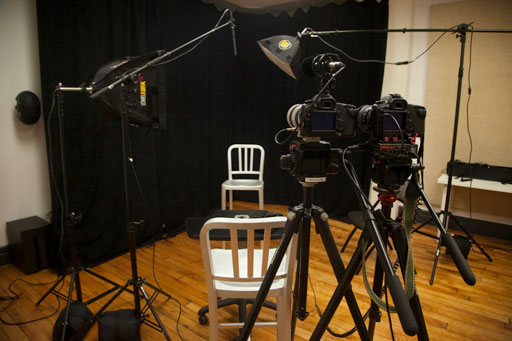 MediaStorm’s standard interview setup is meant to provide a clean, focused environment for the viewer. It can be used both in a studio or in the field. We typically use at least two cameras, usually three, both for visual variety and for editing on-camera sequences. This is by no means the only way to conduct an interview and you should consider the role and look of the interview before beginning a project.
MediaStorm’s standard interview setup is meant to provide a clean, focused environment for the viewer. It can be used both in a studio or in the field. We typically use at least two cameras, usually three, both for visual variety and for editing on-camera sequences. This is by no means the only way to conduct an interview and you should consider the role and look of the interview before beginning a project.
The example below is for an interview with the subject sitting screen-right. If you want the subject to be sitting screen-left, camera and lighting placement should be reversed.
Visual Look
Background – We often use a black background behind our subjects to focus attention on what the subject says and how he or she says it. A large felt cloth works nicely.
Cameras – We currently use the Canon 5D Mark III for our interviews.
Camera Settings – It’s important to standardize settings on all cameras. Make sure each camera has the same frame size, frame rate, aperture, ISO and white balance. Below are the settings we generally use on interviews in our studio. Note that your aperture, ISO and white balance will be different based on your lighting setting up.
Frame size – 1920×1080
Frame rate – 24 frames per second
Shutter speed – 1/50
Aperture – 4.5
ISO – 500
Kelvin – 4500
Camera Position – The wide shot (Camera A), is positioned on the right. The tight shot (Camera B) is positioned on the left. They are as close to each other as possible and should be near the same height. The cameras are both positioned nearly over the shoulder of the person conducting the interview. Make sure the interviewer’s shoulder is not in the shot.
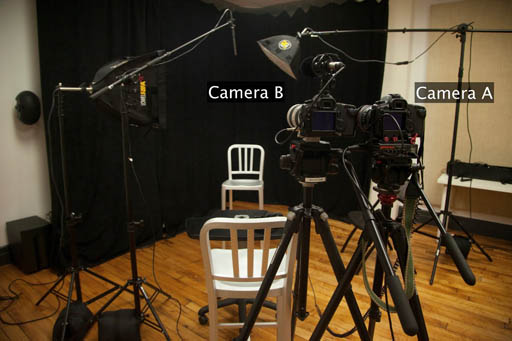
Camera A (Wide, On-Tripod) – The subject is sitting screen-right, looking into the frame screen-left. The subject is composed so that his or her hands are visible laying on their lap. This allows the wide angle to capture any hand gestures or body movement that might be storytelling body language.

Camera B (Tight, On-Tripod) – This shot is also composed with the subject sitting screen-right, looking into the frame screen-left. Composition of the subject should mimic that of the wide shot.
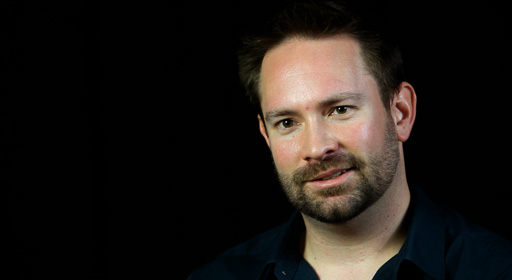
Camera C (Tight, Off-Tripod) – This camera is optional and requires an additional photographer for an interview. We use this camera to show the subject in profile on screen-right looking screen-left. We vary composition with this camera, sometimes focusing on details like the subject’s hands, as well as wider shots of the subject in profile.
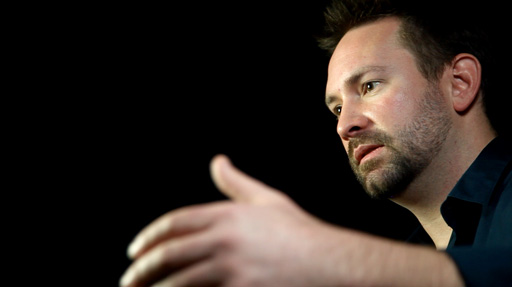
Audio
Microphone Position – MediaStorm uses a Sennheiser ME66 shotgun mic supported directly over the subject’s forehead. The mic should be as close to the subject’s forehead without being in the wide shot. As you can see in the image below, the shotgun mic is supported by a boom on a lightstand, pointing down toward the location of the subject’s forehead.
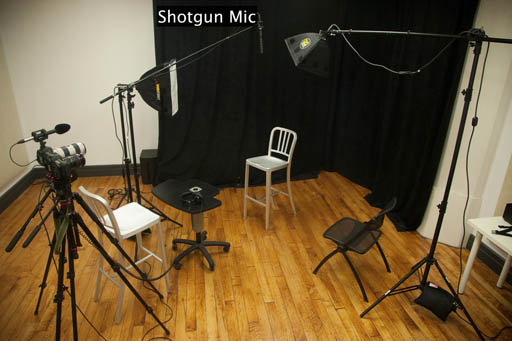
Audio Setup – The shotgun mic is connected to a camera mounted juicedLink via an XLR cord. The juicedLink is a preamp that records higher-quality sound directly to the camera’s audio track, has XLR inputs and allows headphone monitoring. We place the juicedLink on Camera A. This will be the main audio source for the interview.
Cameras B and C have mics mounted on their hot shoes, plugged directly into the DSLR’s mic mount. The audio for these cameras must be clean, but they will be used primarily for syncing in post-production. If you’re using the stabilizer function on Camera C’s lens (the stabilizer should be off for Camera A and B when on tripod), it’s imperative that you use a separate mic. The sound of the stabilizer will ruin the audio of the onboard mic making the camera difficult to sync in post.
Levels for all cameras should be recorded at the industry standard of between -12 and -6db.
Lighting
Key Light – The main light source, or key light, should be on the subject’s screen-left portion of his or her face. See the example below.


Fill/Hair Light – The fill/hair light provides additional light on the screen-right portion of the subject’s face, while separating the subject’s shoulders from the background. We place this light on a boom pole that is above and to the right of the subject, pointing down at the subject’s shoulder and face.
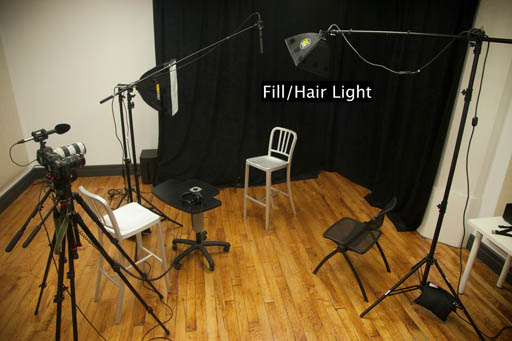
Equipment List
Lights
Audio
- juicedLink RA222
- Sennheisser ME 66
- Rode Video Mic Pro
- K-Tek KE-89CC Avalon Series Aluminum Boompole with Internal Coiled XLR Cable
- Manfrotto Boom Assembly, Black – 6.5′ (2m)
- XLR Cord
Tripod
Camera Equipment

